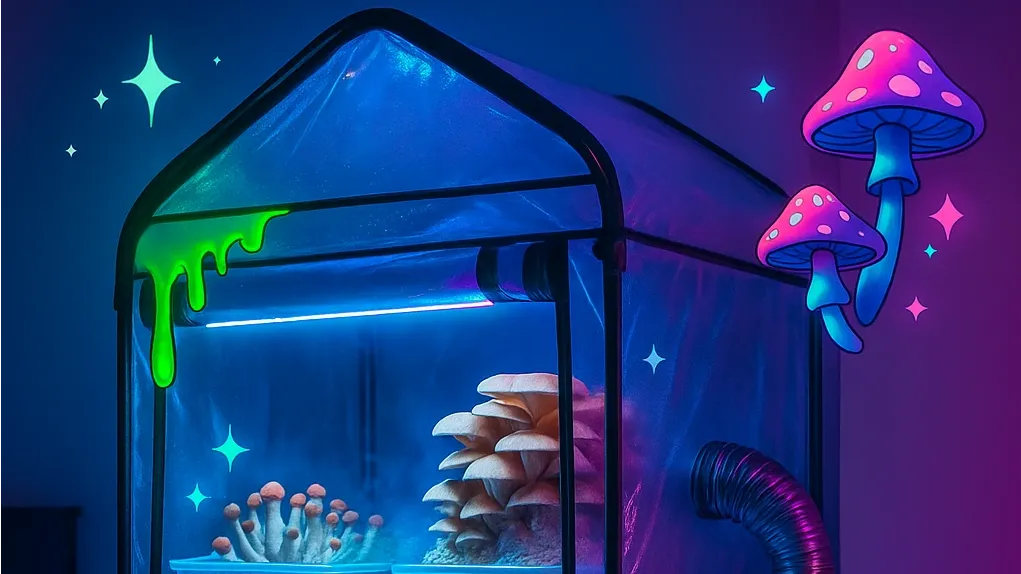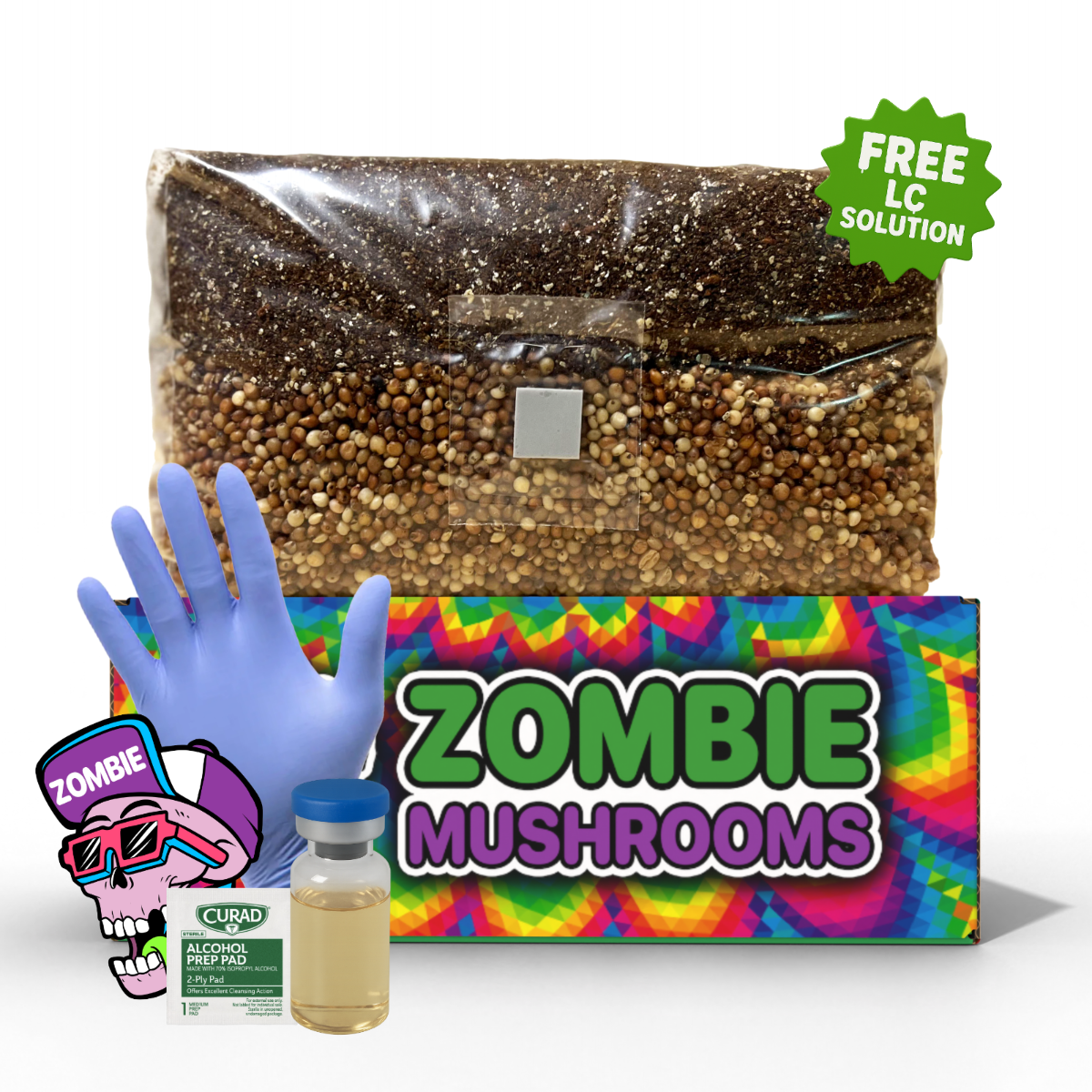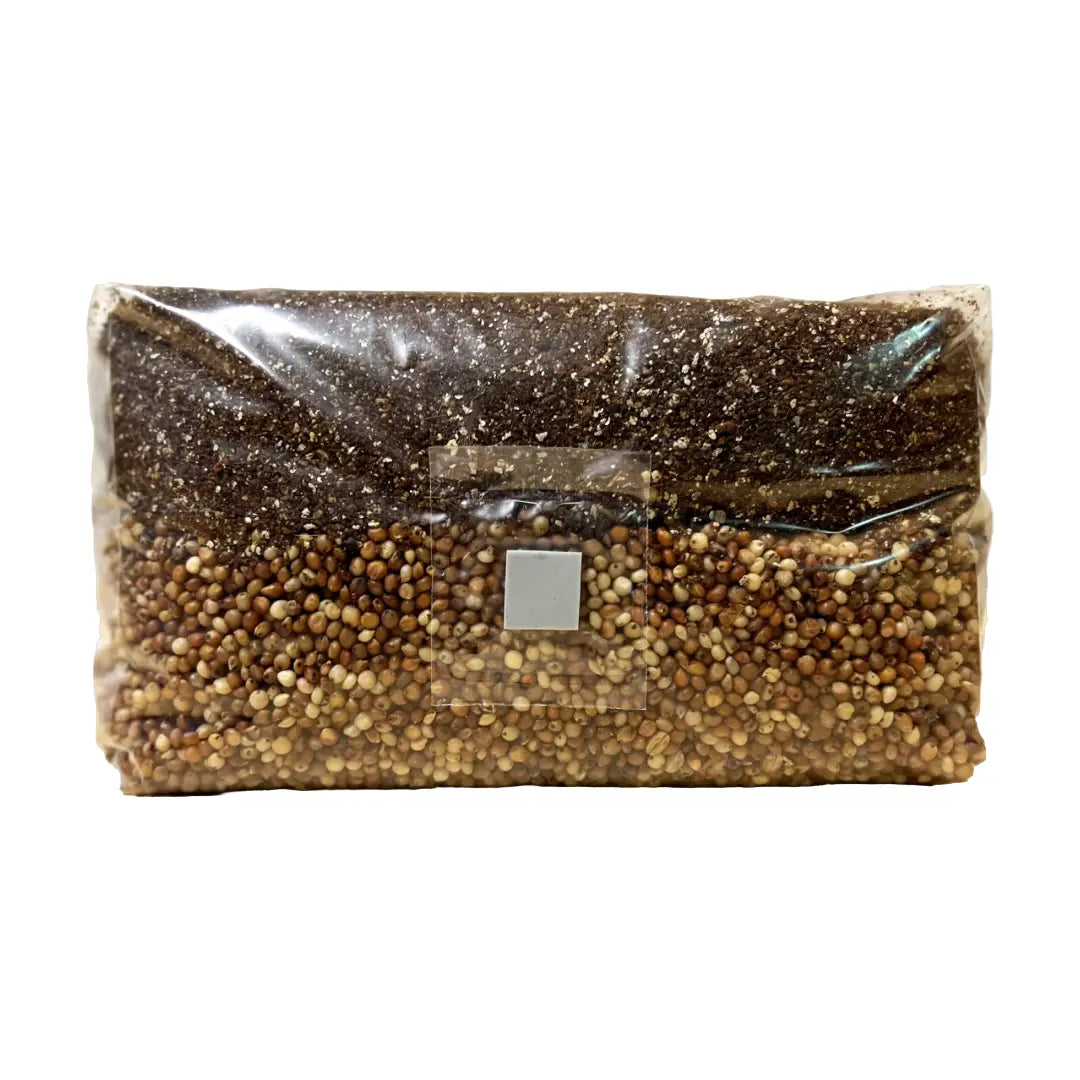⬇️ Prefer to listen instead? ⬇️

- 🍄 Martha fruiting chambers help grow more mushrooms by controlling humidity and airflow.
- 🌬 Moving fresh air often in Martha setups cuts down CO2 and makes mushrooms better.
- 🧪 Monotubs are more contained but give you less control over the growing conditions and are harder to use for many mushrooms.
- 🛠 Martha chambers need more equipment and care but let you grow many kinds of mushrooms at once.
- 👨🍳 Gourmet mushrooms like Lion’s Mane and Shiitake grow better in Martha-style setups.
Martha Fruiting Chamber: Is It Better Than a Monotub?
Indoor mushroom growing has changed a lot. It moved from simple home grows in plastic tubs to better setups for growing special mushrooms used in food and medicine. People who grow mushrooms for fun or in small amounts now have to choose between two popular fruiting systems: the simple monotub and the more advanced Martha fruiting chamber. Each has its good points and bad points. Knowing these differences is key if you want to grow more, better, and faster. For growers who want an even easier entry point, our mushroom grow bags make the process simple and beginner-friendly while still delivering great results.
What Is a Martha Fruiting Chamber?

A Martha fruiting chamber is a changed vertical greenhouse setup made for growing mushrooms indoors. This idea came from small greenhouses once sold under the Martha Stewart brand. Mushroom growers started changing them into places with high humidity and good airflow for mushrooms. After a while, “Martha chamber” became a common name for any tiered greenhouse with controls for the air.
This chamber has many parts, like humidifiers (ultrasonic or evaporative), fans to move fresh air, hygrometers, and automatic controllers like the Inkbird IHC-200. With shelves, growers can stack many trays, grow bags, or containers. Each one can hold a different kind of mushroom. This setup makes it much easier to grow more, with more accuracy, and get more done.
If you grow mushrooms that need steady and exact conditions—such as Lion’s Mane, Pink Oyster, or Shiitake—the Martha fruiting chamber works much better than simpler growing spaces.
Monotub Overview: Simplicity Meets Success
A monotub is a simple way to grow mushrooms. It uses one opaque plastic storage tub. Growers make a large amount of substrate, add mushroom spawn to it, and let the mycelium grow inside the closed tub. Holes are drilled into the tub (often at the substrate level and above). These holes are filled with polyfill or micropore tape. This helps air move slowly while keeping bad things out.
This system is popular because it is simple and cheap. Most home growers, especially those with Psilocybe cubensis, start with a monotub. It gives good results with little trouble.
Pros of the Monotub:
- 🤑 Costs little: Materials often cost less than $20–$30.
- 🙈 Easy to hide: Small size and low noise make it good for quiet grows.
- 🧰 Simple to use: No fans, controllers, or timers needed.
- 💧 Keeps humidity: A sealed place limits water loss, helping mycelium grow when it spreads.
Cons of the Monotub:
- 📏 Cannot grow many: Adding new tubs means you have to do more by hand. It's not automatic.
- 🌡 Depends on surroundings: Humidity and fresh air depend on the room's air.
- ⚠️ Risks of stopping: Uneven conditions can stop mushrooms from forming or cause mold.
Even though it is simple, a monotub works well for small grows. But its limits show more when growing many mushrooms or different kinds.

Martha Chamber vs Monotub: Key Differences
| Feature | Martha Fruiting Chamber | Monotub |
|---|---|---|
| Cost | 💲 Costs more to start (humidifier, fans, controllers) | 💲 Low starter cost using basic household items |
| Setup Complexity | 🧠 Medium to high, needs wiring and setup | 🧰 Very low, simple to use |
| Humidity Control | 💧 Automatic with controller and mister | 💧 Passive, relies on substrate moisture |
| Fresh Air Exchange (FAE) | 🌬 Active, usually with fans that turn on and off | 🌬 Passive via polyfilled holes |
| Cleaning & Maintenance | 🧽 Needs cleaning between grows, plus filter and pump care | 💨 Low, mostly wipe down and replace polyfill |
| Capacity | 🔁 Holds many trays and different kinds of mushrooms | 🧺 Limited to one substrate at a time per tub |
| Contamination Control | ⚠️ More risk from ducts and fans, but you can control it | 🛡 Better isolated, fewer moving parts/pipes |
This comparison shows how each system works best in different situations. The Martha chamber is for being flexible, and the monotub is for being simple.

Advantages of the Martha Tek Setup
The Martha fruiting chamber is liked by growers with more experience for reasons that all point to one thing: making the growing conditions best.
✅ Increased Fresh Air Exchange (FAE)
Monotubs rely on still air slowly moving through polyfilled holes. Martha Chambers, however, uses fans that move and refresh the air many times an hour. This steady airflow cuts down on CO2, which often stops mushrooms from forming. It also helps caps grow well.
✅ Precise Humidity Control
Martha Chambers lets you set exact humidity levels, usually kept between 85–95% RH, depending on the mushroom kind. Controllers like the Inkbird watch humidity and change foggers as needed. This makes sure mushrooms don't stop growing in dry air or get too wet from condensation. This is very important for mushrooms like Lion’s Mane. They often grow badly in less-than-ideal humid conditions (Stamets, 2000).
✅ Vertical Space Efficiency
By stacking shelves, Martha setups turn a vertical space into productive growing room. Each shelf can hold a different tray. This lets a grower grow many kinds of mushrooms or big batches at the same time. A monotub cannot do this without setting up many of them.
✅ Species and Strain Flexibility
Mushrooms that need a lot of care and fail in sealed containers often do well in Martha chambers. Mushrooms that need different humidity and fresh air levels as they grow—like Shiitake, Oyster, or Enoki—grow well in controlled and changing conditions.
Challenges of Martha Chambers
Even with its good points, the Martha Chamber has downsides.
💸 Cost Barrier to Entry
A full Martha setup—with the mini greenhouse, humidifier, fans, ducts, ground cover, controllers, and maybe shelf changes—can cost more than $100–$200. The price depends on how well you build it. For new growers trying things out, this first cost can be a turn-off.
🔧 Maintenance and Monitoring
More parts mean more care. Humidifiers need regular cleaning. Mister nozzles can clog. Filters wear out. Fans get dusty. You need to check things often to make sure they work best and don't break.
🌬 Risk of Over-humidification
If there isn't enough airflow, a very humid place can get too much condensation. This raises the chance of green mold and bacterial spots. Correct fan placement, turning exhaust fans on and off, and regular checks are needed to stop problems (Hodge & Howard, 1995).
How to Build a Martha Setup (Step-by-Step)
Materials Checklist:
- ✅ 4–5 tier greenhouse with clear zippered cover
- ✅ Ultrasonic or cool-mist humidifier
- ✅ Inkbird IHC-200 humidity controller
- ✅ Two small fans (for air in and out)
- ✅ Flexible ducting (for mist delivery)
- ✅ Hygrometer and thermometer
- ✅ HEPA filter and polyfill for air coming in
Step-by-Step Guide:
- Choose Your Location: Put your greenhouse in a clean room where not many people walk. The temperature should be steady, between 65°F–75°F.
- Install the Humidifier: Put it outside the tent. Use ducting or tubing to push mist into the chamber using a small fan.
- Fan Configuration: Put a fan at the bottom to bring mist in. Put another at the top to push old air out.
- Controller Setup: Connect the humidifier to the Inkbird controller. This will make misting happen on its own.
- Sensor Placement: Put hygrometer and thermometer sensors in the middle of a shelf. This will give correct readings.
- Seal and Monitor: Use polyfill or HEPA filter material to keep dust and spores out of the air ducts.

Maintaining Ideal FAE and RH in a Martha Tent
To get healthy mushrooms without mold or weird shapes, balancing the air is very important.
💧 Humidity Guidelines:
- 🦁 Lion’s Mane, Shiitake, Oyster: 85–95% RH
- 🌾 Grain spawn growing (outside Martha): ~70–80% RH
- 📉 Keep humidity within ±5% changes to stop odd growth.
(Source: National Center for Home Food Preservation, n.d.)
💨 Fresh Air Exchange (FAE):
- Try to change the air 3–6 times each hour.
- Set fans on 15-minute timers or controller settings.
- Make sure air flows up steadily. This stops areas with no air movement.
(Source: Hu & Zhang, 2007)

Is a Grow Tent a Good Alternative?
A mushroom grow tent, often used in hydroponics, can also be used as a fruiting chamber. These tents are strong, often block light, and have spots for fans and filters built in.
Grow Tent Pros:
- Looks good and insulates better
- Strong zippers and frames last longer than cheap greenhouse kits
- Can block light if needed for mushrooms that react to light
Cons:
- No windows to look inside
- A bit harder to clean because of the fabric inside
- Few vertical trays unless you add shelves
With changes, a mushroom grow tent can be almost as good as, or better than, a Martha setup. This is true especially for growers who need to control smell or add more insulation.
Mushroom Kinds Best Suited for Martha Tek
Some kinds of mushrooms just won't grow well in a monotub. Here are the best ones for the Martha setup:
🌿 Top Picks:
- Lion’s Mane (Hericium erinaceus): Needs steady humidity and lots of fresh air to grow its toothy spines.
- Shiitake (Lentinula edodes): Does well with cooler temperatures and high humidity. It also forms pins often.
- Oysters (Pleurotus spp.): Grows fruit fast, needs a lot of oxygen. Good for Martha fans and foggers.
- Reishi (Ganoderma lucidum): Long fruiting times mean Martha's steady conditions are a big help.
🧠 Use Monotubs for:
- Psilocybe cubensis: Handles closed spaces well. Grows fine with slow fresh air and high CO2 early on.
- Panaeolus cyanescens: Grows little indoors, but does better in small, low-airflow containers.
When Should You Use a Monotub Instead?
If you are new, don't have much money, or want something simple, a monotub is a good way to start. Times when a monotub is better:
- 🛠 Beginners who want something simple
- 🧪 Steady success with Cubensis and similar kinds
- 💵 Low money limits (under $30 per tub)
- 🧳 Small grow space or need to hide it
You can grow more, but it means managing many tubs instead of one main unit.

My Dream Martha Setup: A Grower's Wishlist
If you have the money, think about this improved setup for growing indoors for a long time:
- Rolling 4-shelf plastic greenhouse with zippered plastic cover
- Two ultrasonic humidifiers with pipes for ducting
- Two fans for air in/out with carbon pre-filters you can change
- Inkbird controllers for temperature and humidity
- Thermometer and hygrometer on each shelf
- Floor pan that stops drips with a drain outside
- Backup power unit (UPS battery) for power cuts
Which Setup Is Right for You?
Both monotubs and Martha chambers have a place in growing mushrooms indoors. Beginners who want something cheap and easy will feel more sure starting with a monotub. Growers who want to grow more, try different mushrooms, or get their growing conditions just right will get good long-term results by putting money into a Martha setup or even a custom mushroom grow tent.
No matter what you pick, the good part about growing mushrooms is learning from each grow. Start simple, watch what happens, and improve your setup over time. Your mushrooms, and how many you grow in the future, will get better with each cycle.
Citations:
Stamets, P. (2000). Growing gourmet and medicinal mushrooms (3rd ed.). Ten Speed Press.
Hodge, K. T., & Howard, D. H. (1995). Fungal contaminants in indoor environments. Mycopathologia, 131(1), 43–54. https://doi.org/10.1007/BF01102938
National Center for Home Food Preservation. (n.d.). Humidity Control in Agriculture. Retrieved from https://nchfp.uga.edu/
Hu, M. Y., & Zhang, J. (2007). Fresh air exchange rates for sustainable food growth environments. Journal of Indoor Environmental Quality, 17(3), 201–209.






